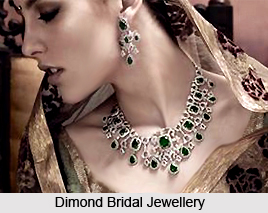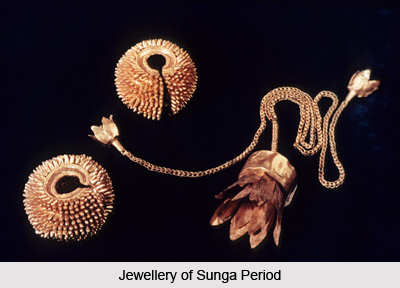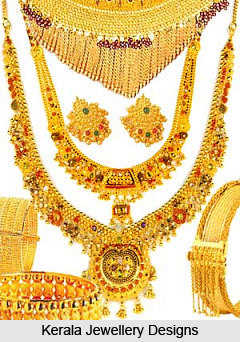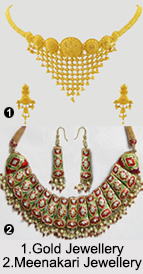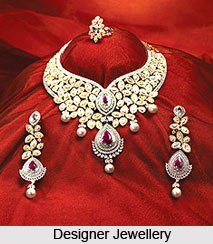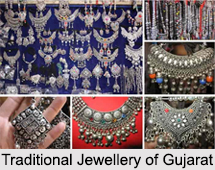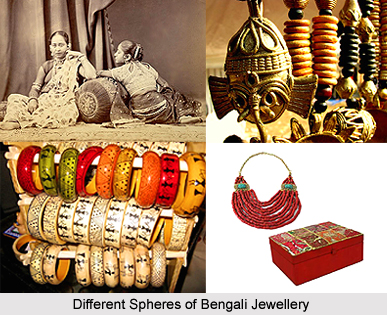 Tribal Jewellery of West Bengal deals with traditional style and maintains the cultural ethnicity of India. Some of the main metals that are used in making jewellery in the state of West Bengal can be mentioned as Gold, precious stones, silver, brass and zinc alloys, etc. Swankars is basically the caste that involved in jewellery making. They used to make jewellery for the affluent higher class as well as the traditional tribal ornament typical of the State of West Bengal. Rose water sprinkle, pendants, brooches, armlets, hairpins etc are some of the examples of good and unique craftsmanship of West Bengal. All of them are very exquisite in style.
Tribal Jewellery of West Bengal deals with traditional style and maintains the cultural ethnicity of India. Some of the main metals that are used in making jewellery in the state of West Bengal can be mentioned as Gold, precious stones, silver, brass and zinc alloys, etc. Swankars is basically the caste that involved in jewellery making. They used to make jewellery for the affluent higher class as well as the traditional tribal ornament typical of the State of West Bengal. Rose water sprinkle, pendants, brooches, armlets, hairpins etc are some of the examples of good and unique craftsmanship of West Bengal. All of them are very exquisite in style.
There is a lot of similarity in the filigree work of the Maukhali area of Bengal with that of the type found in Orissa. In both the cases the techniques resemblances in many ways kundan setting of uncut gems as well as the open claw setting of multifaceted gems, are practiced today along with a European influence of high tech sophisticated gadgetry used for polishing and cutting. Both the techniques need lot of hard work and dedication. It required lot of skills also to excel in the field.
In present days the common trend is something different than the older days. These days the craze is for lighter ornaments and intricate work, which demands a lot of skill from the craftsmen. Tribal designs are still preferred as they still retain the essentials of traditional jewellery and also enable the costumes to gel with accessories of hair clasps, hairpins, necklaces and nose rings. They have been carrying the ethnicity since ages.
Tikli
Tikli is a traditional ornament worn by Bengali brides on the central parting of her hair. This is basically used in forehead. These are laced with a string of pearls and studded with a precious stone or beautiful gold or silver design incorporated with excellent craftsmanship. This can be called as the specialty of West Bengal.
Kaan
Kaan is the other type of traditional ornament worn on the ear. This is made up of thin sheets of gold or silver that covers the entire ear. It embedded with precious stones and is worn on special occasions.
Chik
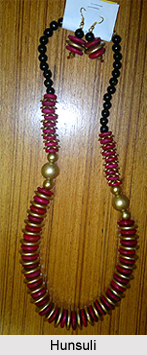 Chik or a gold choker is also other variety. This is almost an inch wide and studded with diamonds or precious stones. This is worn around the neck during traditional gatherings and social occasions. A necklace having five to seven strands of precious stones or beads is known as a Pancha or Sapta lahiri. All of these are various kinds of necklaces, which carry lot of pride.
Chik or a gold choker is also other variety. This is almost an inch wide and studded with diamonds or precious stones. This is worn around the neck during traditional gatherings and social occasions. A necklace having five to seven strands of precious stones or beads is known as a Pancha or Sapta lahiri. All of these are various kinds of necklaces, which carry lot of pride.
Hunsuli
Hunsuli was traditionally worn by Muslim women. But now a day several women of West Bengal are wearing it. It is made in finely crafted silver and is worn snugly around the neck.
Baju, tabiz or tagaa are the traditional ornaments worn around the arm which are delicate hollow bangles expertly crafted in gold or silver. These ornaments are able to enhance the feel of a woman in a very soft way and give the expression of womanhood.
The varieties of Choories or bangles are worn around the wrists. These are of many designs and are mainly crafted in gold or silver. Married Bengali women wear bangles made of conch shell followed by iron ones symbolizing married status. They also wear something called kankan or a thick gold or silver bangle and this is considered auspicious and has filigreed decorations. Kankan is considered auspicious because of the makara pair or the mythical crocodile heads at the ending point of the circle. All of these can be used by the married women only.
Chur and Ratnachur
Chur is a bracelate that is made in pure gold and can be traced in the olden paintings and sculptures. Ratanchur is made in gold and silver and has its origin from the Mughal culture. It begins from five fingers followed in each hand and thumb and ratanchur has five chains attached to each ring. Many of these have decorated moon, lotus and sun at the back of the hand. The jewelers take proper care in making each item. These are regarded, as very precious and proper care should be taken.
Mantasha
Mantasha is an elegant Bengali bangle embedded with precious stones and pure pearls. Married ladies are seen wearing toe rings accompanied by plain or designed chains on their ankles having small bells hanging. These are called payals and are also worn by the spinsters. All of these jewellery is used by the tribal as well as the other people.
Dokra
Dokra is a form of tribal jewellery in the states of West Bengal. It is symbol of craftsmanship. This form of metal casting is one of the oldest forms of metal casting and is technically known as `cire perdue` or lost wax process. This lost wax process or `Cire Perdue` is implemented to cast brass, bronze, or any of the noble metal. A replica of the desired product is made with wax on a clay core with all it finer details of designs and decorations. Dokra castings basically comprise of different decorative accessories like lamp holders, lamps, chains, figures and various symbols of tribal folklore and religion as well as exquisite tribal jewelry of ethnic Indian designs and patterns. No dokra items are similar, and this is a unique feature of Dokra.


